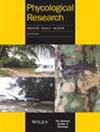波浪暴露、海岸水平和清理季节调节潮间带早期藻类的丰度和演替
IF 1
4区 生物学
Q2 MARINE & FRESHWATER BIOLOGY
引用次数: 0
摘要
潮间带群落的分带模式和结构受潮汐条件的控制。在泰国普吉岛潮间带,在不同程度的波浪暴露、海岸水平和清理季节下,对藻类的多样性、丰度和演替进行了实验测试。藻类定居的死珊瑚斑块(20 厘米 × 20 cm)在旱季和雨季期间,在遮蔽和半暴露的海岸上的上、中、下海岸水位被清除。在被清除的地块上招募的17种藻类中,包括8种红藻目、8种绿藻目和1种褐藻科,有3种占优势:Ulva paradoxa、Vaughaniella阶段的Padina和Polysiphonia sphaerocarpa。半裸露海岸的藻类多样性高于遮蔽海岸。在演替过程中,在半裸露海岸的中海岸水平清理的地块上,悖论虫被广泛招募并持续的时间比其他地块长。雨季清理的地块比旱季清理的地块更丰富。Ulva悖论持续了大约5到6天 几个月后被清除,然后被后来的两个物种取代,Vaughaniella阶段的Padina和P.sphaerocarpa。由于其机会主义特征和对长时间出现的特殊生理适应,矛盾Ulva比其他藻类物种更容易在清理过的地块上定居并持续更长时间。根据这项研究,波浪暴露程度、海岸线和清理季节可能在藻类的补充、丰度和演替模式中发挥重要作用。本文章由计算机程序翻译,如有差异,请以英文原文为准。
Wave exposure, shore level, and season of clearing modulate early algal abundance and succession in an intertidal zone
Zonation patterns and the structure of intertidal communities are controlled by tidal conditions. Algal diversity, abundance and succession were experimentally tested under different degrees of wave exposure, shore level, and season of clearing at the intertidal zone, Phuket, Thailand. Dead coral patches colonized by algae (20 cm × 20 cm) were cleared at upper, middle, and lower shore levels on sheltered and semi‐exposed shores during both the dry and rainy seasons. Of 17 algal species, including eight Rhodophyta, eight Chlorophyta, and one Phaeophyceae that were recruited on the cleared plots, three species were dominant: Ulva paradoxa, Padina in the Vaughaniella stage, and Polysiphonia sphaerocarpa. Algal diversity on the semi‐exposed shore was higher than on the sheltered shore. In the successional process, U. paradoxa extensively recruited and persisted longer on plots cleared at the middle shore level on the semi‐exposed shores than at the other. It showed a greater abundance in the plots cleared in the rainy season than those cleared in the dry season. Ulva paradoxa persisted for around 5 to 6 months after clearing and was then replaced by the two later species, Padina in the Vaughaniella stage and P. sphaerocarpa. Ulva paradoxa settled more easily and persisted longer at the cleared plots than other algal species because of its opportunistic characteristics and a special physiological adaptation to long periods of emersion. From this study, degree of wave exposure, shore level, and season of clearing likely play important roles in algal recruitment, abundance, and succession patterns.
求助全文
通过发布文献求助,成功后即可免费获取论文全文。
去求助
来源期刊

Phycological Research
生物-海洋与淡水生物学
CiteScore
3.60
自引率
13.30%
发文量
33
审稿时长
>12 weeks
期刊介绍:
Phycological Research is published by the Japanese Society of Phycology and complements the Japanese Journal of Phycology. The Journal publishes international, basic or applied, peer-reviewed research dealing with all aspects of phycology including ecology, taxonomy and phylogeny, evolution, genetics, molecular biology, biochemistry, cell biology, morphology, physiology, new techniques to facilitate the international exchange of results. All articles are peer-reviewed by at least two researchers expert in the filed of the submitted paper. Phycological Research has been credited by the International Association for Plant Taxonomy for the purpose of registration of new non-vascular plant names (including fossils).
 求助内容:
求助内容: 应助结果提醒方式:
应助结果提醒方式:


